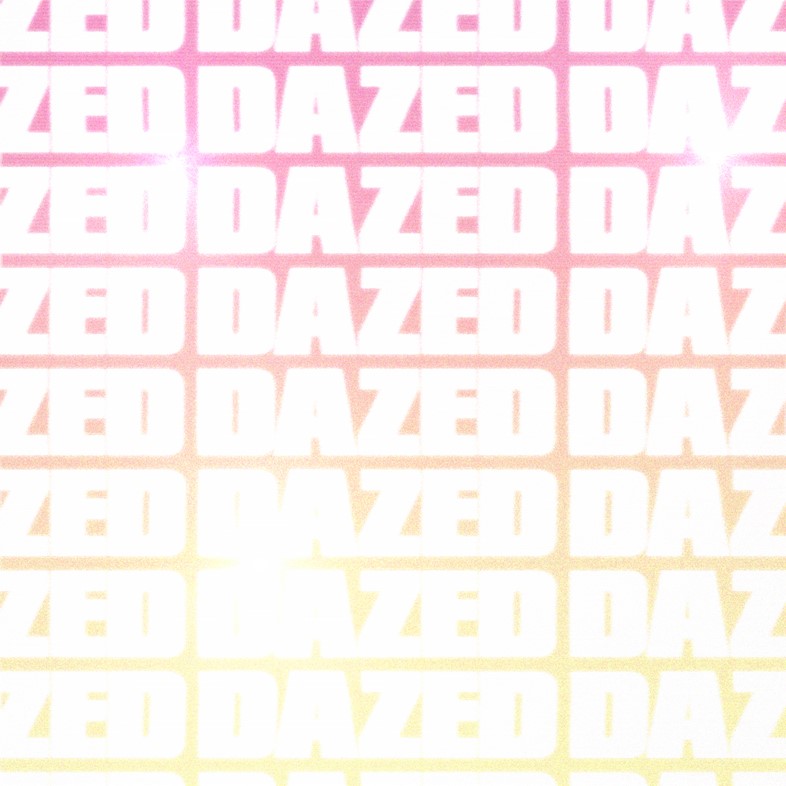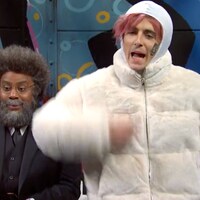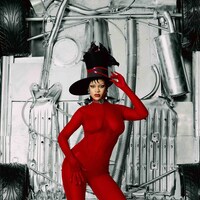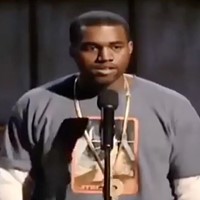Artists from Kehlani to Harry Styles are openly singing about both sides – and doing it on their own terms
Earlier this month, Kehlani and Demi Lovato concluded the US leg of their Tell Me You Love Me tour by kissing on a rotating stage bed. Mainstream pop is, of course, no stranger to demonstrations of Sapphic affection – growing up, MTV gave us Katy Perry’s “I Kissed a Girl” with all its “cherry chapstick” and “experimental games”, while Madonna and Britney shared an iconic kiss during their VMA performance – but as Lovato giggled over Kehlani, pushing her over and grinding into her, something felt different. In the past, those artists would ‘play gay’ for shock value. Here, both artists are actually queer – and they’re not alone. Today, bisexual musicians are more visible than ever in pop, with new artists writing wistful love songs using same-sex pronouns and chart-topping stars waving pride flags on-stage.
Last year, Halsey’s “Strangers” – featuring fellow bisexual artist Lauren Jauregui – became the first female same-sex love song to make the Top 40. Janelle Monáe’s new album Dirty Computer featured music videos comically strutting between male and female love interests, while Harry Styles recently previewed a song with lyrics about “messing about” with both boys and girls. Even Eminem, who spent much of his career portraying gay men as lecherous sex pests (“Pants or dress, hate f**s? The answer’s yes / Homophobic? Nah, you’re just heterophobic,” he rapped on “Criminal”), recently claimed to be using Grindr, although it was hard to ascertain whether this was a weak attempt at humour or not.
When the mainstream did flirt with bisexuality in the past, it tended to paint it as either experimentation or subversive eroticism – and always catering to a heteronormative gaze. Rihanna spends the whole of seductive Latin anthem “Te Amo” dancing in front of a hot fireplace, toying with (but ultimately rejecting) the idea of sleeping with another woman. In “Not Myself Tonight”, Christina Aguilera gyrates in bondage gear while presenting same-sex passion as pathological: “Someone call the doctor ‘cause I’ve lost my mind”. Lovato herself has seen an evolution in her portrayal of bisexuality – compare her kiss with Kehlani to when she was criticised for her bi-pop anthem “Cool for the Summer”, where she sings of a female fling that’s only acceptable for the duration of a holiday. In an interview with PAPER, Halsey expressed concern over the idea of a bisexuality as an experimental hookup: “Oh, yeah. Bisexuality as a taboo. ‘Don’t tell your mom’ or ‘We shouldn’t do this’ or ‘This feels so wrong but it’s so right’.”
Likewise, many seemingly ‘out’ bi pop stars have later claimed that this was either just a phase or, worse, a marketing stunt. Jessie J came out as bisexual early in her career, before later dismissing her comments: “I want to stop talking about it completely now and find myself a husband,” she told The Mirror. In “Lil Freak”, Nicki Minaj promises a timid-looking video girl that if she lets her touch her “kitty kat” she would take her “to see Usher”, but subsequently admitted she was feigning bisexuality for attention. This isn’t a new phenomenon – David Bowie, one of the earliest queer icons to gain prominence in pop, flitted between embracing and rejecting bisexuality throughout his life, once telling a journalist that “the biggest mistake I ever made” was declaring he was bisexual.
“When the mainstream did flirt with bisexuality in the past, it tended to paint it as either experimentation or subversive eroticism – and always catering to a heteronormative gaze”
A breakthrough for bisexuality’s recent visibility in music came when Frank Ocean posted an open letter to Tumblr in 2012, which alluded to past relationships with men and turned him into a new queer icon overnight. Prior to that, coming out in public was often highly staged, with stars working with big media outlets and granting exclusive interviews to engineer their big reveal. But Ocean came out on his own terms, casually uploading a TextEdit screenshot onto the internet, complete with unedited spelling mistakes and a freeform writing structure. Rather than letting anyone turn his sexuality into a commodity, Ocean set the pace for other stars to choose how to present their own queerness.
Ocean has never stated his sexuality in interviews, but last year’s “Chanel” saw him use lyrics that were specifically bi: “I see both sides like Chanel.” The two curving lines of the Chanel logo refer to these two different clefts of sexuality, with lyrics like “my guy pretty like a girl” rubbing up against “I need that bitch to grind on my belt”. Kehlani’s 2017 anthem “Honey” is similarly unambiguous. The blurry, DLR-style home video shows her making out with a girl as she sings: “I like my girls just like my honey.” They sit on picnic blankets in straw fields and watch the sunset. Honey oozes down plump lips. Here, bisexuality is not a phase, but a deep emotional connection, fortified by hand-holding and dreamy stares into lovers’ eyes. Kehlani recently opened up about her sexuality on Twitter, rejecting a straightforward male/female gender binary, and writing: “I’m queer.”
Perhaps the most popular artist to recently embrace both sides with his lyrics is Harry Styles, who previewed a new track, the raspy love song “Medicine”, with the lyrics, “The boys and the girls are here / I mess around with him / And I’m okay with it.” Styles’ solo career has seen him channel the radically feminine aesthetic of 1970s male glam rock icons, wearing luxurious blouses, louche bows, and long wispy hair, while slinking his hips like Mick Jagger. It’s possible that he’s simply playing with similar aesthetic ideas to these artists, but with his use of pride flags in live shows, and his tweeting the lyrics from King Princess’s queer love anthem “1950”, these moves appear engineered to encourage a queer reading of his music. It was bound to resonate with a portion of his audience who used to write slash-fiction that imagined Styles in queer relationships with other One Direction members.
A recent performance of “Medicine” showed Styles doused in electric blue and magenta pink lights, an affect crowned “bisexual lighting” by queer Twitter, where the hyper-saturated colours of the bisexual flag fill a space like in a Nicolas Winding Refn film. Pansexual star Janelle Monáe used the colours in her “Make Me Feel” video, where she licks lollies with rumoured girlfriend Tessa Thompson, singing “that’s just the way that I feel” and “I can’t help it!” In her new video for “Pynk”, Monáe is even more forthright: in the middle of a rose-coloured desert, she swallows the head of her girlfriend in the floating layers of some labia-shaped pants while singing: “Pink like the inside of your, baby… Pink like your fingers in my, maybe.”
Positive representations of bisexuality are especially crucial right now given that bisexual people are doubly discriminated against, both by other members of the queer community and by straight people. Stereotypes of bisexual people as greedy, promiscuous, and fickle are still prevalent today – they’re perceived to be either too frightened to come out, or to be nymphomaniacs who will eventually settle down into a definitively homo or heterosexual relationship. It is unsurprising, then, that a 2017 study found bisexuals are more vulnerable to mental health issues than other queer identities, with added stigma leaving them prey to loneliness and isolation.
While nuanced presentations of bisexuality are important, the policing of queerness as though it is some objective standard is problematic. Commentators have accused Halsey of not using enough female pronouns on her songs. PopMatters wrote that “although Halsey has referenced being bisexual in interviews, it’s only in ‘Bad at Love’ and ‘Strangers’ that she references loving women”, while Buzzfeed asked whether Halsey’s VMA look of glittery bell bottoms, underboob, and long hair indicated a desire to appear straight. The idea that bisexuals are not gay enough erases them from the LGBTQ+ community. The problem lies in determining where personal choice ends and commercial imperative begins – it’s fun to experiment with same-sex love, but it’s not okay for pop stars to shrug off labels when they are no longer in fashion.
Given the increasing sexual ambiguity of today's teenagers it is unsurprising that marginal identities are carving out a space in mainstream pop. There is a hunger for representation of specifically bisexual experiences, especially given that a recent YouGov poll revealed 49% of young people in the US identify as something other than exclusively heterosexual, and 19% see themselves as somewhere in between homosexual and straight. These songs are a desperately needed rebuke to a morose political climate where being gay is increasingly criminalised by those in power.
When pop stars flirt with bisexuality to sell albums, they exploit a group who already face massive marginalisation. But the mainstream has to create more genuine presentations of bisexuality if they want to satisfy Gen Z teenagers. Rather than two women sharing lipgloss for a couple of seconds in order to tantalise the commercial gaze of gossip columns, pop stars are providing more nuanced presentations of bisexual love. Less a phase, more a commitment.




